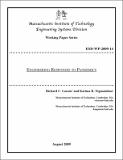Engineering Responses to Pandemics
Author(s)
Larson, Richard Charles; Nigmatulina, Karima R.
Downloadesd-wp-2009-14.pdf (1.922Mb)
Metadata
Show full item recordAbstract
Focusing on pandemic influenza, this chapter approaches the planning for and
response to such a major worldwide health event as a complex engineering systems problem. Action-oriented analysis of pandemics requires a broad inclusion of academic disciplines since no one domain can cover a significant fraction of the problem. Numerous research papers and action plans have treated pandemics as purely medical happenings, focusing on hospitals, health care professionals, creation and distribution of vaccines and anti-virals, etc. But human behavior with regard to hygiene and social distancing constitutes a first-order partial brake or control of the spread and intensity of infection. Such behavioral options are “non-pharmaceutical interventions.” (NPIs) The chapter employs simple mathematical models to study alternative controls of infection, addressing a well-known parameter in epidemiology, R0, the “reproductive number,” defined as the mean number of new infections generated by an index case. Values of R0 greater than 1.0 usually indicate that the infection begins with exponential growth, the generation-to-generation growth rate being R0. R0 is broken down into constituent parts related to the frequency and intensity of human contacts, both partially under our control. It is suggested that any numerical value for R0 has little meaning outside the social context to which it pertains. Difference equation models are then employed to study the effects of heterogeneity of population social contact rates, the analysis showing that the disease tends to be driven by high frequency individuals. Related analyses show the futility of trying geographically to isolate the disease. Finally, the models are operated under a variety of assumptions related to social distancing and changes in hygienic behavior. The results are promising in terms of potentially reducing the total impact of the pandemic.
Date issued
2009-08Publisher
Massachusetts Institute of Technology. Engineering Systems Division
Series/Report no.
ESD Working Papers;ESD-WP-2009-14
